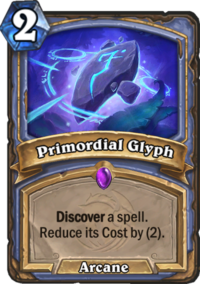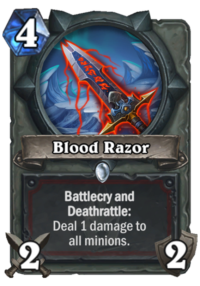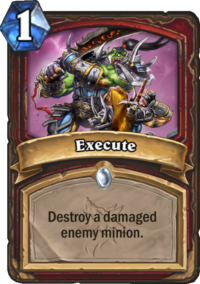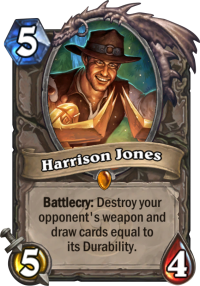Card games, by rule, can feel unfair. Sometimes you don’t draw the right cards, sometimes your opponent gets all the perfect answers, and sometimes your starting hand is five nine drops. Whatever the scenario, there is no doubt there are going to be games where things are stacked against you. However, what about the times where you lose and it’s your fault?
Many people play Hearthstone and believe that everything comes down luck. There is always an excuse why they lose. Of course their opponent had that card, of course they couldn’t find their finisher in time. While it would be nice to know that all of your losses are out of your control, that is typically not true. In fact, most of the time you lose it is because you took the wrong route, made a misplay, or simply didn’t use your cards correctly. In this article, we are going to explore such situations to look at the most common reasons people lose in Hearthstone and then discuss how to fix them.
Luck in Hearthstone & Card Games
There is an old saying in Magic: “You are always going to win 33 percent of your games, and you are always going to lose 33 percent of your games. It is the other 33 percent that separates the good from the bad.” Not only is that quote also relevant to Hearthstone, but it touches upon one of the most important aspects of this article: luck.

A good lesson to learn is that luck is an inherent part of all card games. You draw cards, which means there are always going to be times where you just cannot get your curve going. In addition, there are going to be certain swings that are completely out of your control. You cannot do anything about Barnes pulling Y'Shaarj, Rage Unbound, nor can you plan for your Rogue opponent Swashburglaring a clutch Pyroblast. These are things that happen. The point is not to try to figure out ways around those insane plays, but rather to determine when things are luck and when they are much more in your control.
That idea is going to be the overall theme of this guide, but you should always do your best to evaluate turns where things went wrong. Attributing all of your losses to luck doesn’t make you a better player. In fact, a lot of the time it makes you worse because you are no longer analyzing the game in the proper way. After you lose the board, or when your opponent makes a great play, you should think about the previous turn to see where things went wrong.
That may sound a bit tedious, but it will greatly improve your game for two reasons. One, it will give you a better understanding of both Hearthstone and the matchup you’re currently in. Two, it helps you figure out when things are in and out of your control. This can greatly reduce tilt and help you notice such scenarios in future games. If you lose to a magic top deck or RNG effect (which happens) recognize that. However, do not just write things off to randomness when you missed a key play. Introspective is a huge step towards getting better and you should always apply it while grinding on the ladder.
Inefficient Trades
Another big mistake people make in Hearthstone is taking bad trades. It is very easy (most of the time) to look at a board and calculate what you need to do. Trade your two drop into a three drop? Check. Buff your 2/1 to kill a 6/6? Check. However, what about making trades to set up your next turn? That is much trickier to do, and something that can be hard to see at any one time.

For example, let’s say you (a Control Warrior player) are up against a Midrange Hunter. You have a Blood Razor you coined out turn three with no board and your opponent has a Kindly Grandmother they played turn two. Many people would just attack face in this situation, which seems like a fine play. Not only do you get two face damage, but you also pop the grandmother and limit Houndmaster value.
However, it is typically better to attack the grandmother. Why? Because your deathrattle goes second in this situation, which then puts one damage on the 3/2 wolf. Then, when your opponent Houndmasters on turn four you can Execute the wolf or finish it off with the Sleep with the Fishes when you otherwise would have no answer.
The other play leaves you facing down two non-damaged minions that you can do nothing to. As such, while you may blame bad luck when you die to your opponent’s top decked Kill Command on turn six, it is actually the extra damage you took by not properly attacking that cost you the game.
The above situation is quite common. Players lose to top decks that they themselves could have prevented and then they blame it on the game. Trading does not always simply mean killing a minion. A lot of the time it is setting up your damage to get a good board in the coming turns. Very few classes have ways to buff or heal minions, and if you aren’t playing against Priest you should always play to your future damage as much as you can.
Even doing something as simple as trading a 1/1 into a 5/5 so it cannot hit your 4/4 and live can be the difference between losing the board and getting back into as game. Bodies will always matter in Hearthstone, and if you aren’t focused on the future you will likely lose tempo. Even if a card is not in your hand, there are going to be many times where putting your opponent’s high-value threat in range of a top decked Truesilver Champion or Dragonfire Potion is the difference between winning and losing.
Before you attack always think about what you’re getting from that play. If face damage matters, go face. However, if you need to keep a hold on the board, or if you need to set up a future play, do not be afraid to slam a small minion into a bigger one.
Card Conservation
Probably the most overlooked mistake players make in Hearthstone is not using their cards at the right time. As with trades, this is very hard to spot when you’re going through a game, which is why it is so often ignored. Many people will Hex or Execute a five drop without thinking and then die to a much bigger threat six or seven turns later. Yes, it stinks your opponent managed to find The Lich King on curve, but you also should have had a clean answer. You gave it away.

The idea of card conservation boils down to using your cards at their peak efficiency. What makes it difficult is that efficiency changes each game and shifts depending on the situation at hand. Hex, as noted, needs to be saved for something like The Lich King when playing against a slow control deck, but against Aggro Druid or Pirate Warrior you can easily burn it on something like Crypt Lord or Southsea Captain because you need to limit damage.
Even hitting a Vilespine Slayer against Tempo Rogue to stop Shadowstep can be a good play. However, you also don’t want to use premium removal on a slayer when you can burn a Jade Lightning. In that same vein, if you can trade into a big threat or slowly chip away at it with taunts that will help you save your removal for later on.
Another great way to look at this concept is through AOE like Brawl or Dragonfire Potion. Often, people just pull the trigger on those when they feel like they can get sufficient value. Your opponent has four minions and you have AOE, what’s not to like? However, that’s not how card games are played. Hearthstone is all about conservation, where you want to wait to use your most powerful tools at the last possible second. Yes, you may be able to kill four things right away, but that could then leave your vulnerable to a swarm attack later on. Rather than just drop your AOE because you can, you want to look for other ways to contest the board. Maybe you have some taunts, maybe you just want to play out a couple of minions. If you aren’t under immediate threat of dying you should not be afraid to hold back an extra turn or two.
The best way to get use out of card conservation is to ask yourself “what else could I do this turn?” in addition to “what am I saving this card for?” Looking at your other options is the first step towards knowing whether you need to play a key card or not. If you have other routes, then you should almost always take them. In addition, if your opponent has a big card (like Bittertide Hydra in Aggro Druid) or a strong finisher (N'Zoth, The Corruptor) that you need to be prepared for, don’t give up your only out.
Now, all that being said, this is not a strict rule to live by. Every game is different, and there are going to many times where you need to use a card at an inopportune moment in order to stay alive or pull ahead. However, this section is focused on the other times where you have a little more breathing room. That extra few seconds of analysis will give you a big edge.
Adaptation
While all of the above points are important, none are as key as properly adapting to the current meta. I have been writing Hearthstone articles and recording gameplay videos for three years, and in that time I have found the most successful decks to be the ones that properly anticipate the ladder. Even one or two choice cards can raise a win rate over ten percent, and in the star system that is a huge jump.
Check out our List of the Best Standard Decks for Hearthstone Ladder

While some people (many people) adopt the “if you can’t beat them, join them” policy in card games, the players with the biggest successes tend to be the ones who constantly try to adapt. Just about every single popular deck has a weakness. It may not always be a big weakness, but you should always think about strong counters to the archetypes at the top of the pile.
Just about every list in Hearthstone has a few tech slots that can be freely tweaked to adapt to the meta. Sometimes you want The Black Knight, sometimes you want Harrison Jones, and sometimes you want something more subtle like Crazed Alchemist. Whenever you use one of your precious thirty slots on a card you need to have a good reason for it being there. When teching you need to ask yourself what specific purpose the card is going in for, as well as what deck it will help you beat.
Learn more about teching your deck with our Tech Card Guide!
Note that this decision is not always going to be a straight up one-for-one answer like “well, Acidic Swamp Ooze eats weapons. Sometimes you just need to lower your curve to beat aggro, and sometimes you might need an extra big finisher or Death Knight just to beat control. Those decisions are key to any deck, and they can be applied to any tier. Do not play the same 30 as someone else because they had success with it. Each rung of the ladder is its own small meta, and you want to tech for what you’re seeing the most.
You should also not be afraid to look into the past. So many times people will overlook a strong deck that got played a few months ago because they think it is outdated. However, as the meta shifts, there are many times where outdated decks get their chance to shine. For instance, I am currently storming up the ladder with a Quest Warrior list that a few people I know have brought to legend. While the deck died out of popularity, it is a great call right now because of how strong it is against both swarm decks and Priest. Always look for holes in the meta (or in meta decks) and then find ways to exploit them. Just because you’re losing one matchup a lot does not mean you should give up on your deck, it just means you need to adapt.
Conclusion
The first step towards recovery is admitting you have a problem, and the first step towards getting better at Hearthstone is admitting you aren’t perfect. Everyone, no matter how good they are, makes key mistakes. As you play, try your best to identify what those mistake are and then do what you can to limit them. Analyze your plays and don’t just take the obvious lines because they are there. The more you think about future turns in relation to the current one, the better you will be. Thanks for reading!

I would much prefer if they give us auto squelch so we dont have to deal with tilts and can help us play the game better. Preserving social aspects as a reason is really a dumb reason when u have already disabled chat for the purpose of preventing trolls.
“However, it is typically better to attack the grandmother. ”
Lol – hard to imagine any context other than Hearthstone where this sentence would appear…
Magic is not less rng then hearthstone, just diffrent. In magic u dont have cards that make other random cards, but u have to put mana cards in your deck and the deck depends on having just enoght mana. To much mana is bad and to little even worse. In hearthstone u have a hero power that makes your bad turns a little better and u get fixed mana. This makes a huge diffrence in magic and the card draw rng is alot more random.
There is an old saying in Magic: “You are always going to win 33 percent of your games, and you are always going to lose 33 percent of your games. It is the other 33 percent that separates the good from the bad.”
——
Magic is less random than Hearthstone though, from Yogg to the random Lich King card(s) you get, to Babbling Book and Cabalist’s Tome … and so on, it’s probably closer to 40/40/20 in HS 😛
However, you can reduce the luck factor of your own draw a bit by having a tonne of card draw in the deck; a fact Miracle Rogues have been relying on since forever. (Wild) Malygos Miracle Rogue is still my favourite archetype but I’m quite enjoying (Standard) Exodia Mage as well now – both decks are hugely reliant on card draw to hit their win condition before they run out of health and get that big ol’ OTK.
A definitive guide for people who are just starting.
Something that backs up the point failure is only a step to learn.
And another problem with the newer players are, they get demotivated for lacking some of the cards which does leave them at a disadvantage.
The thing is, one can always find replacements. Just until you get to the point where you have enough dust to make a legit deck.
For example. Let’s say you are lacking shaklu the collector. You could simply replace him with Vicious Fledgling. And Sunkeeper Tarim with stonehill defender. Trust me it really works out better at times. With a lil bit of rng. You could just win it all.. gl out there folks.
Very well written article! An interesting read. Thanks!